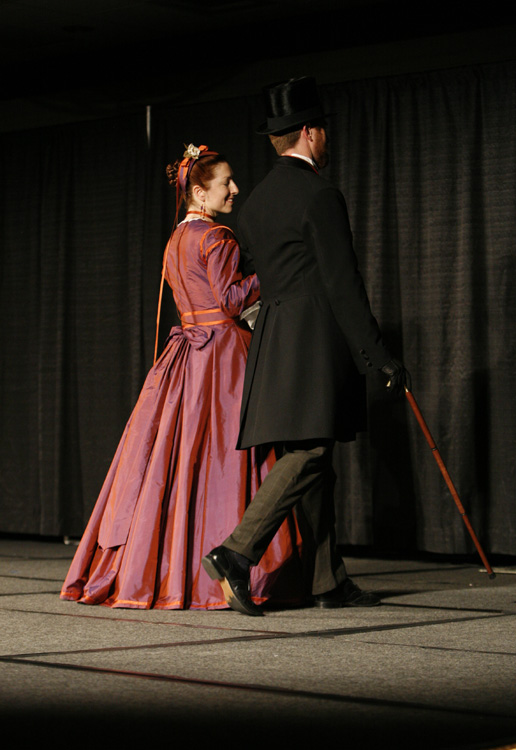
August 2007 – April 2008
I’ve had my sights set on making the Laughing Moon frock coat pattern #109, since innocently waltzing into my first sewing class, pattern in hand, in Fall 2004. Since then, the project has been started at least half a dozen times, and then re-shelved. But finally last fall I decided this coat was not going to get the best of me! I set a deadline for myself – Costume Con in April 08, and began the process again.

1856: Fashion et Theorie
New York Public Library, Picture Collection on line
This 1856 fashion plate was the main inspiration for Aaron’s overall look. In addition to the frock coat, I made a Victorian shirt, brocade vest, wool windowpane pants, and a silk neckwear set for his masquerade entry. The hat, gloves and cane were purchased. I’m just thrilled with how the whole costume came together. Given the number of Victorian events we attend, it should also prove to be a practical addition to the wardrobe.
A few minor changes were made to the pattern to allow for turn of cloth and a better fit. I also took a good 5″ off the tails, shortening them to right above Aaron’s knees. But the most significant alteration I made to the pattern was to draft out some of the ease from the waist. The Laughing Moon coat is based on a garment from 1880. My modification gave the coat’s straight line, an earlier, more shapely silhouette. For the most part I was trying to match the fashion plate. There is also a brief discussion on fit, on page 121 of Cut of Men’s Clothes. “Even in the late 1870s some men still preferred to have their coats made to fit the body closely without padding.” I made an effort, therefore, to keep the chest and shoulder padding to a minimum.



This was my first coat project and I had many construction issues to tackle. I decided that the collar was one pattern piece best left alone. My inspiration image from 1856 does show a very wide lapel. However, here are two examples I pulled up from 1861, from the vast Musee McCord collection. Based these images, I decided the shape was quite close, and within a reasonable time-frame for my project. More recently, I even discovered an 1856-58 photo of a frock coat with a small notched collar (page 1 of Victorian Fashion in America 264 Vintage Photographs). The best part of all of this: the coat will now work for the Edwardian era as well.
As for construction, I followed the methods in Easy Easier Easiest Tailoring by Palmer. The coat front was done with the so-called “easy” method: sew-in hair canvas interfacing, machine-basted to an organza layer, and then hand-taped and pad-stitched to the wool. It’s fully lined in heavy weight silk taffeta. If you look closely at the fashion plate you’ll be able to see the full lining in that coat too. The under collar is felt. The cuff and hem corners are mitered, and it has a full complement of pockets, which includes two in the tails. The collar and buttons are silk satin, though this was not my initial plan. I ended up caving to the peer pressure of Aaron and my mom. I have to admit it’s gorgeous fabric, and adds a certain pizzazz to an otherwise plain black coat. At the same time, working with satin fabric was a challenge, to say the least.
I mentioned earlier that I tried to keep the shoulder and chest padding pretty minimal. Nevertheless, combined with the heavy lining, canvas, and closely woven wool fabric, there’s no doubt that this turned out to be a winter-weight frock coat.
For the first time ever I managed to take progress pictures as I went, since some of the more interesting stuff is actually on the inside.










